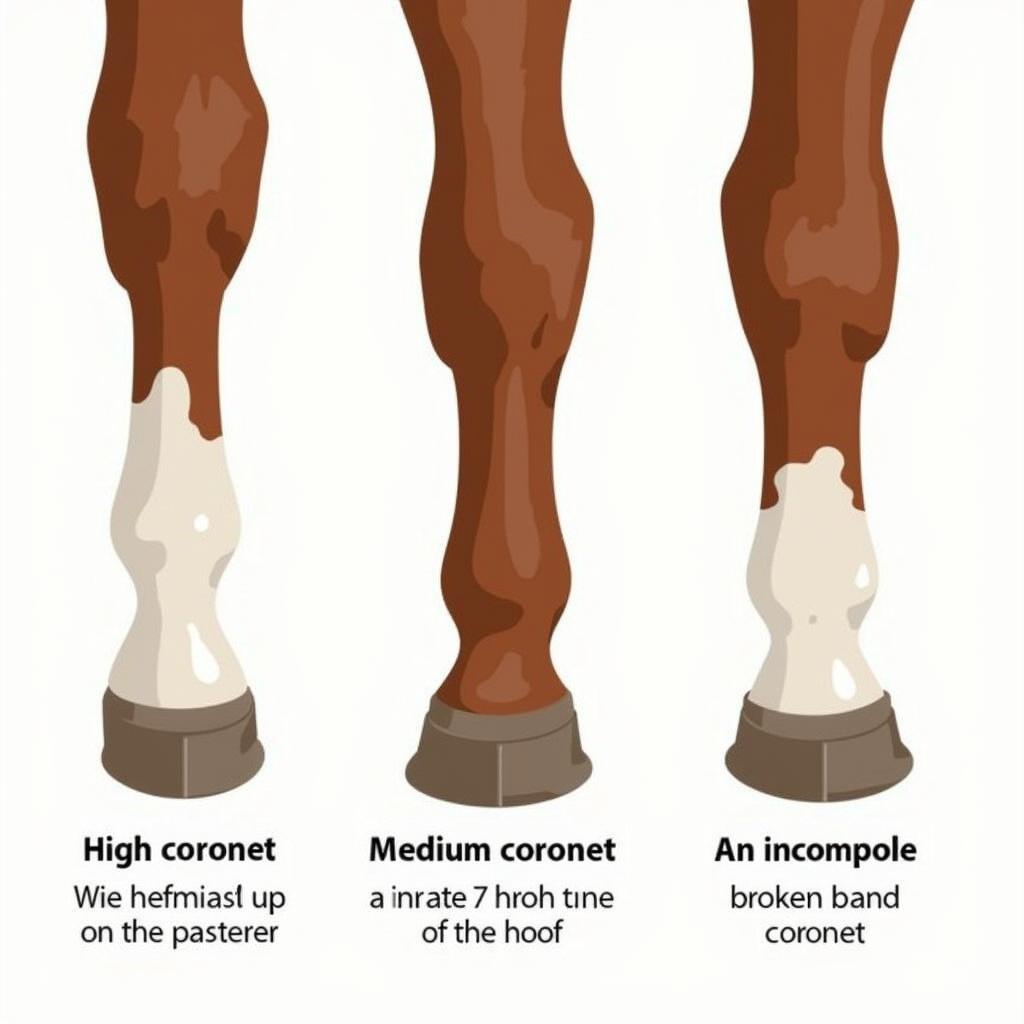A Coronet Horse Marking is a white band just above the hoof, often resembling a crown or coronet, hence the name. It’s a distinctive marking that adds character and individuality to a horse’s appearance. Understanding the various types and nuances of coronet markings can help horse owners identify and appreciate these unique features. Let’s delve into the fascinating world of coronet markings.
Types and Variations of Coronet Markings
Coronet markings can range from a thin, barely-there white line to a broad band encompassing a significant portion of the pastern. The width, height, and evenness of the band can vary greatly, adding to the uniqueness of each marking. Some coronet markings extend slightly up the pastern, while others are confined to the area just above the hoof. Certain variations even have specific names, such as the incomplete coronet, which is a broken band of white, adding even more intrigue to these natural markings. sock horse The variety within coronet markings truly highlights the diverse beauty within the equine world.
 Coronet Horse Marking Variations: High, Medium, and Incomplete
Coronet Horse Marking Variations: High, Medium, and Incomplete
Identifying a Coronet Marking
Identifying a coronet marking is generally straightforward, thanks to its location. It’s crucial to differentiate it from a pastern marking, which extends higher up the leg. A true coronet marking is situated just above the hoof, encircling the coronet band. This distinction is key for accurate identification and record-keeping. Observing the specific characteristics of the white band, such as its width and uniformity, helps determine the specific type of coronet marking.
The Genetics of Coronet Markings
Like many other coat colors and markings, coronet markings are influenced by genetics. While the precise genetic mechanisms are complex, it’s generally accepted that these markings are inherited. Breeding horses with coronet markings can increase the chances of offspring inheriting similar markings, although the exact pattern and extent can vary. Further research into equine genetics continues to unravel the intricate interplay of genes that contribute to the diverse array of coat patterns and markings.
Coronet Markings and Horse Identification
Coronet markings can play a significant role in horse identification, especially in cases where horses have similar coat colors. These distinctive markings serve as natural identifiers, helping to differentiate between individuals. Photographs and detailed descriptions of coronet markings can be valuable tools for horse owners and breeders in maintaining accurate records. This meticulous documentation can prove crucial in situations such as theft or disputes over ownership.
Other White Markings on Horses
Coronets are just one of many white markings that can adorn a horse. From stockings and socks to stars and snips, the combinations are nearly endless. Each marking contributes to a horse’s individual appearance. sock horse Understanding these different markings enhances our appreciation of the unique beauty of each horse.
Conclusion
The coronet horse marking, with its delicate resemblance to a crown, is a fascinating characteristic that adds to the individuality of each horse. By understanding the various types and the genetic factors involved, we can appreciate the subtle nuances of these markings. Recognizing coronet markings also plays a practical role in horse identification. From the thinest white line to a broad band, the coronet marking truly is a mark of distinction.
FAQ
-
What is the difference between a coronet and a pastern marking? A coronet marking is located just above the hoof, while a pastern marking extends further up the leg.
-
Are coronet markings genetic? Yes, coronet markings are influenced by genetics and can be inherited.
-
Can coronet markings be used for identification? Yes, coronet markings can be valuable for identifying individual horses, especially those with similar coats.
-
What other white markings can horses have? Horses can have a variety of white markings, including stockings, socks, stars, snips, and blazes.
-
Do coronet markings have any impact on a horse’s health or performance? No, coronet markings are purely cosmetic and do not affect a horse’s health or performance.
-
How are coronet markings described in horse registration papers? Coronet markings are typically described by their size, location, and whether they are complete or incomplete.
-
Can coronet markings change over time? While the basic pattern usually remains the same, minor variations in the size or shape of a coronet marking can occur as a horse ages.
Have you ever wondered about the unique markings on your horse’s legs? Do you have a horse with striking coronet markings? Share your thoughts and experiences with us! For further assistance, contact us at Phone Number: 0772127271, Email: [email protected], or visit us at QGM2+WX2, Vị Trung, Vị Thuỷ, Hậu Giang, Vietnam. We have a 24/7 customer support team.